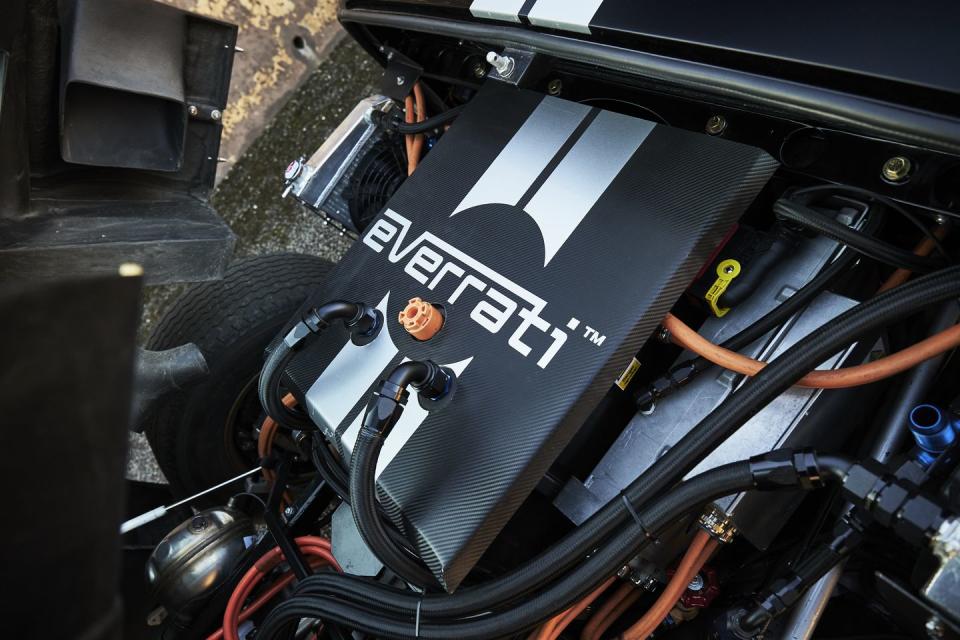This Is an Electric GT40

The classic EV conversion business is booming. Shops removing oily pistons and throwing batteries in their place have been around for a while, giving old cars a new lease on life. A while back, UK startup Everrati made waves by fully restoring a 964 911, swapping out its sainted flat six and popping electricity in its place. Now it’s done something similar to a GT40.
While Porsche has made over a million 911s, Ford didn’t build that many GT40s, so to hear the name associated with an EV swap might send chills down your spine. Fear not, because the GT40 used isn’t an original, but one made by Superformance. Superformance builds continuation cars under license, so they still come with a GT40 VIN, but they’ve not been anywhere near the sixties. The deal here will be, when the car’s development is finished, that you can ask for a V8-powered GT40 continuation, or you can ask for it to be given the Everrati treatment. Diversification in continuation.
Everrati’s car has been in development for ages, and will remain so for a while. Rather than simply throw some electrons in the back and hope, the company prefers to do full scale OEM testing on each of its powertrains to make sure they work in any situation. Hot weather, cold weather, stress testing, you name it. Considering the cost of entry, in the case of the GT40 £440,000 plus local taxes ($540,000), you’d hope it was up to snuff.
The powertrain in the middle of the finished car will be an 800 hp, 590 lb-ft motor hooked up to a 60 kWh battery. That’ll get it from 0 to 62mph in less than 4.0 seconds, and over 125mph. Everrati reckons it’ll do 125 miles on a charge. You can fast charge it, too, so 20 to 80 percent, given the right charger, happens in 45 minutes. As it stands, the car’s still in testing, so there was only 650bhp to play with. For shame.

Despite being a new car, it wasn’t initially designed for an electric powertrain, so Everrati did the same to the Superformance GT40 as it did to its 911, SL Pagoda, Series II Land Rover and upcoming Defender projects - detailed scanning, measuring, and CAD designing to figure out the kind of space they had to work with. As it turns out, they didn't have much. This lead to an interesting battery solution - they sit in the sills, much as the original GT40’s fuel cells did since they won't fit under the floor. Everrati wants its cars to feel nearly identical to the ICE cars it converts, which means weight distribution, power delivery, and even overall weight have to be as close as possible to the original. This is where Everrati’s GT40 does rather well - it has a 40/60 F/R weight distribution (a touch better than the ‘66 MKII’s 38/62) and, according to Everrari, it weighs 2910lbs, a full 103lbs less than a fully fueled original.
Dimensionally, it’s the same size as an ICE GT40, which means if you’re tall you’ll struggle to get in. Hell, even at 5’8'' getting in requires some gymnastics. Oh, and when you’re clambering in or out, look out for the door/roof combo, it’s alarmingly easy to smack your head. Once you’re folded behind the wheel, Everrati’s trim work shines. The dials you’d expect from a GT40 are all there, albeit with an electric twist, pointed towards the driver, away from prying passenger eyes.
The pedal box is tight. There’s no clutch, but having the throttle and brake so close together can, if you’re lucky enough to have size tens, be a challenge. It may be one of the few cases that makes wearing Puma Speedcats acceptable.

 Yahoo Autos
Yahoo Autos 